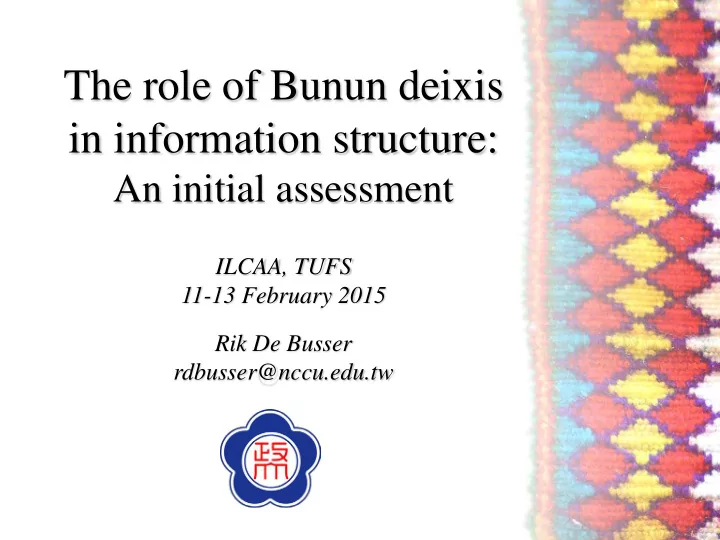

The role of Bunun deixis in information structure: An initial assessment ILCAA, TUFS 11-13 February 2015 Rik De Busser rdbusser@nccu.edu.tw
In this talk • Takivatan Bunun • Spatial deixis ↔ Topicality • Topicality – Clause-level topicality – Discourse-level / Textual topicality
Takivatan Bunun • Bunun (ISO 639-3: bnn) • Austronesian Taiwan • Central dialect • Philippine-type alignment • Highly productive verbal morphology • Data from Bahuan (Mayuan village)
Cross-linguistic functions of deixis • Himmelmann (1996:218ff): Spatio- – Situational: temporal This is a humongous tree . – Discourse deixis: Anaphoric That’s the end of that story. deixis – Tracking: Red, blue and white. These are the colours of the flag. Exophoric – Recognitional use: Do you remember that strange man in Calgary?
Functions of deixis in Takivatan “Many studies on spatial deixis put great stress on the use of deictic markers for anaphoric reference and discourse deixis […]. In Takivatan , the distance dimension in any of the deictic paradigms is rarely used unambiguously for anaphoric reference , most likely because of the existence of the anaphoric marker sia […].” (De Busser 2009:425)
Austronesian deixis and information structure • Association of definiteness and clausal topic, e.g. Tagalog: “Formally, the topic is marked either by the use of a topic pronoun form or by a prenominal topic marker. Notionally, the topic is always interpreted as definite.” (Schachter 1976:494)
Functions of deixis in Takivatan • Deictics are the only explicit morphological markers of definiteness. • No absolute correlation between definiteness and topicality. • Indefinite topics:
Functions of deixis in Takivatan • Primary function – Anaphoric deixis – Clause-level topicality • So deictic markers are not involved in information structure at all???
Deictic paradigms Triple distance distinction: • Definiteness markers (bound) • Third person pronouns (free) • Demonstratives (free) • Place words (free) Discourse function: • Manner word (m)aupa (free) • Anaphoric marker sia (free)
Definiteness markers Referential Situational Proximal -ti -ki Medial -tun -kun Distal -ta -ka • Nominal and verbal hosts • Referential vs. situational (see De Busser 2009)
Definiteness markers
Third person pronouns Singular Plural Proximal isti inti Medial istun intun Distal ista inta • Human and higher animate reference
Demonstratives Visibility ROOT Plurality Distance Ø- ‘VIS’ -p- ‘singular’ -i ‘PROX’ ai- - ŋk - ‘vague plural’ n- ‘NVIS’ -un ‘MED’ -nt- ‘paucal’ -a ‘DIST’ -t- ‘inclusive -Ø ‘USPEC’ generic’
Demonstratives
Place and manner • Place Spatial Temporal ʔiti ‘here’ ‘at this moment’ PROX ʔitun ‘there (medial)’ ‘at that moment MED (medial)’ ʔita ‘there (distal)’ ‘at that moment DIST (distal)’ • Manner – (m)aupa ‘thus, in such a way’
Place and manner Verbal Verbal Adverbial
Anaphoric marker • Sia ‘aforementioned’ Nominal Verbal
Deixis and information structure • No clausal topicality • Phoricity is not the primary function • Establishment of discourse cohesion (cf. Halliday & Hasan 1976): – Establishing topical chains – Marking topical progression
Example • TVN-008-002:130-134 • Story of a deer hunt • Topical chains
Example • Noun: – Establish a discursive topic – Contrast or reinforcement (Reiteration in Halliday & Hasan 1976: 279’s terms)
Example • Deictic words: – Primary function is deixis (except for sia and maupa ) – Maintaining topical chains: anaphoric or exophoric reference as secondary function – Co-interpretation: deictic elements link back to a previous reference in the text, but the anaphor and the anaphoric target do not necessarily refer to identical semiotic denotata (cf. Halliday & Hasan 1976: 314)
Conclusion • Takivatan spatial deictics: – Primary function: spatio-temporal deixis (or a metaphorical extension) – Overlaying function: discourse cohesion – Complex interaction between deictic paradigms, manner words and anaphoric marker
Bibliography Busser, Rik De. 2009. Towards a Grammar of Takivatan Bunun: Selected Topics . Melbourrne: Research Centre for Linguistic Typology, La Trobe University PhD. Halliday, M. A. K. & Ruqaiya Hasan. 1976. Cohesion in English . (English Language Series). London: Longman. Himmelmann, Nikolaus P. 1996. Demonstratives in narrative discourse: A taxonomy of universal uses. In Barbara Fox (ed.), Studies in Anaphora , 203–252. Amsterdam: John Benjamins. Schachter, Paul. 1976. The subject in Philippine language: Topic, actor, actor-topic, or none of the above. In Charles N. Li (ed.), Subject and Topic , 491–518. New York: Academic Press.
Uninaŋ miqumisaŋ !
Functions of deixis in Takivatan • Metaphorical extensions of deixis – Space – Time – Delineation – Animacy – Endearment – Endorsement De Busser (2009: Table 48)
Recommend
More recommend